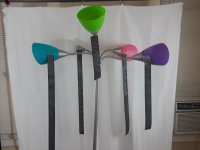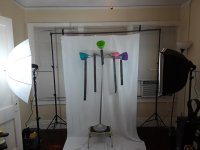The cool thing about having lighting is all the camera settings can be set independently in M (manual mode) for the optical effects your wish. Since you control the background and position relationship between subject and background your Aperture setting is not so critical for exposure when using flash so you can select an aperture that fits your depth of field preference. For this scene, f/5.6 to f/8.0 would assure lens peak performance and deep enough depth of field for sharp focus on all the ribbons. Since you want the least noise, set the ISO to 100, or 200 hundred if your flash is not strong enough
Next, Shutter speed, for sharp images you usually set it fast enough to minimum camera shake blur when shooting with ambient light but your main exposure light with flash is a very fast pulse of light that will freeze any camera or subject movement. The flash duration is around 1/20,000 to 1/30,000 of a second. To synchronize the shutter and flash you need to reduce the shutter speed to be no faster than 1/250th of a second. The second source of light is the ambient light in the room, which is continuous so any camera shake will be recorded before and after the flash goes off. Keeping the shutter speed up to 1/250 will keep the ambient light underexposed enough to not be visible. Lowering the shutter to 1/10...will expose the shake, however. Turn off the flash and take a test shot with ambient light, if the resulting image is dark enough to mask any shake detail you are set.
So now, set the metering to Spot and flash to iTTL mode and make sure the focus point box is right over one of the ribbons so it meters on the subject. The flash power and duration to expose the subject is calculated by the flash so the only variable left determine exposure is the light on the subject is reflected back to the camera. As I mentioned in the prior post, get the subject further away from the background farther will reduce shadow, decrease the brightness of the background and blur it a bit.
Shooting in MANUAL exposure mode is much easier than in any auto mode since the flash contribution is not present when the metering is done so you end up with low flash power, high ISO, slow shutter and long exposure times calculated by the camera. When the flash is absent, the camera, in auto mode meters based on the low ambient light it sees. 99% of Flash and 100% of strobe photography is done in manual exposure mode. Snapshots out walking on the streets or action sports are good times to use Auto exposure, but not when using flash. Manual mode gives control to you for background vs subject exposure,depth of field, and noise control. With enough added light and smaller apertures, the sharpest images you take will be when using flash.




